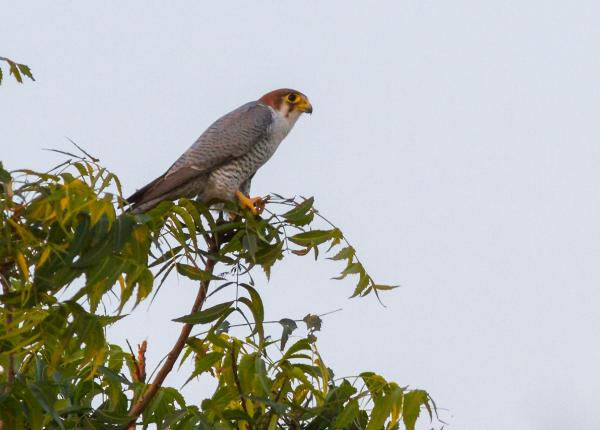Did You Know?
- There are two recognized subspecies of the Red-necked Falcon
- When hunting, this species is often seen doing so in the company of Gabar Goshawks. According to researchers, the hunting success of both species may be improved by this association!
How The Peregrine Fund is Helping
The Peregrine Fund doesn't work directly with Red-necked Falcons, but our efforts in scientific research, habitat conservation, education, and community development help conserve birds of prey around the world. We also supply literature to researchers from our avian research library, which helps scientists around the world gather and share important information on raptor conservation. And, finally, our support of the Global Raptor Information Network gives raptor researchers tools to more efficiently conduct their own studies while contributing to a global program. It also provides citizen scientists a way to participate in raptor science and conservation.
Where They Live
There are two separate populations of Red-necked Falcon, one which is found in Asia and the other is in Africa. Depending on where it lives, it occupies slightly different habitat. In Asia, this species is most often found in open country, desert, and woodland. It can be found nesting near human settlements, and even in large cities in some parts of its range. In Namibia and Botswana it can be found in more arid habitats, while the race found in other parts of Africa seems to prefer woodland habitats, grasslands and savannas.
Why They Need Our Help
The Red-necked Falcon is found across two continents, and is categorized as a species of Least Concern in Africa, and Near Threatened in Asia. While its population is declining in some places and increasing in others, deforestation remains a big threat to this species, especially where palm trees are being destroyed which limits their nesting and roosting habitat.
What They Eat
Both in Africa and in Asia, the Red-necked Falcon shows a preference for feeding on on birds. It will take small passerines and even birds up to the size of a crake or a quail. In Africa, it has also been observed preying upon rodents once in a while, as well as bats, reptiles, and insects such as beetles and termites. This falcon chases its prey on the wing after a quick aerial pursuit.
Nests, Eggs, and Young
Just as the different subspecies are found in different types of habitats, so to do they nest in slightly different places. The race horsbrughi prefers to nest in old stick nests built by crows or other raptor species. They tend to use nests that have been placed in the crown of an isolated tree. The ruficollis race nests in the cavity of the crown of a palm tree or at the base of a palm frond. In general, the Red-necked Falcon will lay 3-4 eggs. The female incubates the eggs, which she must do for around 35 days, and cares for the young after they hatch while the male is responsible for finding enough food to feed himself, the female and the nestlings after they hatch. The young falcons will grow quickly and after 35-40 days they will be ready to fly from the nest for the first time. After the falcons begin flying around, they will remain in their parents' territory for several weeks as they learn to hunt and avoid danger.
Red-necked Falcon and the World Center for Birds of Prey
Though far away from Red-necked Falcon habitat, the World Center for Birds of Prey offers fun ways to learn about falcons and other birds of prey. Interactive activities, tours, interesting videos, and a children's room with activities from coloring sheets to quizzes to costumes await you. The visitor center has many live raptors on display, including several falcon species including a Peregrine Falcon, a Gyrfalcon, an American Kestrel, and an Aplomado Falcon. This is a great chance to see birds of prey up close and learn about the wonderful and interesting adaptations they have in order to survive in their respective habitats. There is also a touch table with feathers and other natural objects available for exploration.
References:
del Hoyo, J., A. C. Kemp, G. M. Kirwan, N. Collar, and J. S. Marks (2020). Red-necked Falcon (Falco chicquera), version 1.0. In Birds of the World (S. M. Billerman, B. K. Keeney, P. G. Rodewald, and T. S. Schulenberg, Editors). Cornell Lab of Ornithology, Ithaca, NY, USA. https://doi.org/10.2173/bow.renfal1.01
Global Raptor Information Network. 2021. Species account: Red-necked Falcon Falco chicquera. Downloaded from http://www.globalraptors.org on 9 Dec. 2021









